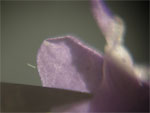 |
|||||
 |
 |
||||
 |
|||||
 |
 |
||||
Compass Microscope (No. 85) |
||||||||||
 |
Age: c. 1740-1750 Made by: unknown Made in: unknown |
|||||||||
 |
||||||||||
|
Imaging
|
||||||||||
|
This Compass Microscope was used for viewing small opaque objects. To use the instrument, the user would mount the specimen with the stage forceps and locate it just above the lens (in the middle of the reflector). They would then hold the "back" side to the eye and view the sample through the center lens. The silvered reflecting mirror, or "Lieberkuhn", focuses more light on the top surface of the specimen. The microscope has a brass body and solid ivory handle. It fits into a violin-shaped case covered with tan leather with a padded satin interior. There are two simple lenses with this instrument. They provide either 5x or 10x magnification and quite good imaging. The microscope has a hinged specimen holder held in a fixed sleeve. It consists of a stage forceps on one end and a cork-filled brass cylinder at the other end. The holder may be rotated to use either end. Focusing is accomplished by sliding the shaft of the specimen holder in the sleeve to attain the proper position in front of the lens; which is mounted in the center of the Lieberkuhn reflector. The microscope is 15cm long. Instruments of this type are called "Compass" microscopes because of the center hinge, reminiscent of a drafting compass. Some instruments folded in half (for storage) at this hinge. Others, like this instrument in the Golub Collection placed the specimen holder at the center. These instruments proved to be very popular by the middle of the 18th century into the early 19th Century because they were inexpensive and simple to use. They were often included as an accessory magnifier for opaque specimens to a screw-barrel microscope. Microscope featured 07/08 |
||||||||||